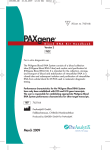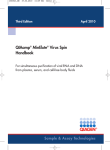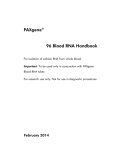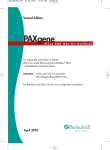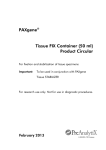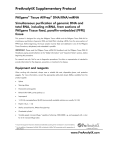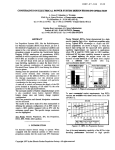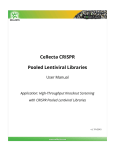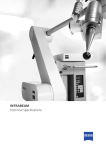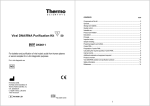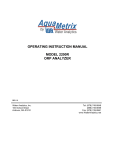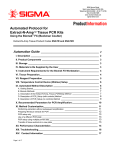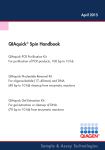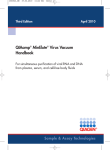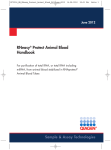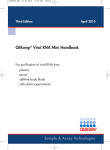Download PAXgene® - PreAnalytiX
Transcript
1051083_HB 22.04.2008 16:44 Uhr Seite 1 Σ PAXgene 50 ® B l o o d R N A K i t H a n d b o o k Version 2 IVD The PAXgene Blood RNA System consists of a blood collection tube (PAXgene Blood RNA Tube) and nucleic acid purification kit (PAXgene Blood RNA Kit). It is intended for the collection, storage, and transport of blood and stabilization of intracellular RNA in a closed tube and subsequent isolation and purification of intracellular RNA from whole blood for RT-PCR used in molecular diagnostic testing. Performance characteristics for the PAXgene Blood RNA System have only been established with FOS and IL1B gene transcripts. The user is responsible for establishing appropriate PAXgene Blood RNA System performance characteristics for other target transcripts. For in vitro diagnostic use REF 762174 H B 1051083 PreAnalytiX GmbH, Feldbachstrasse, CH-8634 Hombrechtikon R1 Produced by QIAGEN GmbH for PreAnalytiX MAT 1051083 April 2008 1051083_HB 22.04.2008 16:44 Uhr Seite 2 Trademarks: PAXgene®, PreAnalytiX™ (PreAnalytiX GmbH); QIAGEN®, QIAcube® (QIAGEN Group); BD Vacutainer®, BD Hemogard™, Safety-Lok™ (Becton, Dickinson and Company, Franklin Lakes, NJ, USA); Eppendorf® (Eppendorf-Netheler-Hinz GmbH). PAXgene Blood RNA Kits are not available in all countries; please inquire. Limited License Agreement Use of this product signifies the agreement of any purchaser or user of the PAXgene Blood RNA Kit to the following terms: 1. The PAXgene Blood RNA Kit may be used solely in accordance with the PAXgene Blood RNA Kit Handbook and for use with components contained in the Kit only. PreAnalytiX grants no license under any of its intellectual property to use or incorporate the enclosed components of this Kit with any components not included within this Kit except as described in the PAXgene Blood RNA Kit Handbook and additional protocols available at www.preanalytix.com . 2. Other than expressly stated licenses, PreAnalytiX makes no warranty that this Kit and/or its use(s) do not infringe the rights of third-parties. 3. This Kit and its components are licensed for one-time use and may not be reused, refurbished, or resold. 4. PreAnalytiX specifically disclaims any other licenses, expressed or implied other than those expressly stated. 5. The purchaser and user of the Kit agree not to take or permit anyone else to take any steps that could lead to or facilitate any acts prohibited above. PreAnalytiX may enforce the prohibitions of this Limited License Agreement in any Court, and shall recover all its investigative and Court costs, including attorney fees, in any action to enforce this Limited License Agreement or any of its intellectual property rights relating to the Kit and/or its components. For updated license terms, see www.preanalytix.com . © 2005–2008 PreAnalytiX GmbH, all rights reserved. PreAnalytiX PreAnalytiX GmbH Feldbachstrasse CH – 8634 Hombrechtikon Switzerland PreAnalytiX Distributors PreAnalytiX products are manufactured for PreAnalytiX by QIAGEN or BD and are distributed for PreAnalytiX by QIAGEN or BD. Products cannot be ordered at PreAnalytiX GmbH. Please see the last page for contact information for your local PreAnalytiX distributor. 1051083_HB 22.04.2008 16:44 Uhr Seite 3 Contents Explanation of Symbols 4 Kit Contents 6 Storage Conditions 7 Intended Use 7 Product Use Limitations 8 Quality Control 8 Technical Assistance 8 Safety Information 8 Introduction Principle and procedure 11 11 Sample collection and stabilization 11 RNA concentration and purification 16 Manual RNA purification 18 Automated RNA purification 26 Equipment and Reagents to Be Supplied by User 30 Important Notes 31 Using the QIAcube 31 Starting the QIAcube 31 Installing protocols on the QIAcube 31 Loading the QIAcube 33 Protocols Manual Purification of Total RNA from Human Whole Blood Collected into PAXgene Blood RNA Tubes (BRT) Automated Purification of Total RNA from Human Whole Blood Collected into PAXgene Blood RNA Tubes (BRT) 39 45 Troubleshooting Guide 50 Appendix A: General Remarks on Handling RNA 52 Appendix B: Quantification and Determination of Quality of Total RNA 53 Appendix C: Handling PAXgene Blood RNA Tubes 55 Ordering Information 56 PAXgene Blood RNA Kit Handbook 04/2008 3 1051083_HB 22.04.2008 16:44 Uhr Seite 4 Explanation of Symbols Σ <N> i Contains sufficient for <N> tests Consult instructions for use Use by Do not reuse IVD In vitro diagnostic medical device REF Catalog number LOT Batch code MAT Material number COMP Components NUM Number STERILE R Method of sterilization using irradiation KU Kunitz units Temperature limitation Upper limit of temperature Manufacturer i Important note ? EtOH Write down the current date after adding ethanol to the bottle Upon arrival ADD 4 Adding PAXgene Blood RNA Kit Handbook 04/2008 1051083_HB 22.04.2008 16:44 Uhr Seite 5 CONT Contains RCNS Reconstituted DNase Deoxyribonuclease I EtOH Ethanol GITC Guanidine isothiocyanate RNase-Free DNase Set ➡ RNase-Free DNase Set Leads to PAXgene Blood RNA Kit Handbook 04/2008 5 1051083_HB 22.04.2008 16:44 Uhr Seite 6 Kit Contents PAXgene Blood RNA Kit (50) Catalog no. Number of preps 762174 50 BR1 Resuspension Buffer BUF 20 ml BR2 Binding Buffer* BIND BUF 18 ml BR3 Wash Buffer 1* WASH BUF 1 BR4 Wash Buffer 2† (concentrate) BR5 Elution Buffer ELU RNFW RNase-Free Water (bottle) PEL WASH PK Proteinase K (green lid) PRC PAXgene RNA Spin Columns (red) PAXgene RNA COL PT Processing Tubes (2 ml) PROC TUBE Hemogard Secondary BD Hemogard™ Closures SEC CLOS MCT Microcentrifuge Tubes (1.5 ml) MIC TUBE RNFD DNase l, RNase-Free (lyophilized) DNA REM RDD DNA Digestion Buffer (white lid) DNA DIG DRB DNase Resuspension Buffer (tube, lilac lid) DNase PSC PAXgene Shredder Spin Columns (lilac) RES WASH BUF 2 CONC 45 ml 11 ml 6 ml BUF 2x 125 ml 2x 1.4 ml PROTK 5 x 10 6 x 50 50 3 x 50, 1 x 10 1500 Kunitz units‡ BUF RES BUF PAXgene SHRED COL 2 x 2 ml 2 ml 5 x 10 Table continued overleaf * Not compatible with disinfecting reagents containing bleach. Contains a guanidine salt. See page 8 for safety information. † Wash Buffer 2 (BR4) is supplied as a concentrate. Before using for the first time, add 4 volumes of ethanol (96–100%, purity grade p.a.) as indicated on the bottle to obtain a working solution. ‡ Kunitz units are the commonly used units for measuring DNase I; see page 40 or 46 for definition. 6 PAXgene Blood RNA Kit Handbook 04/2008 1051083_HB 22.04.2008 16:44 Uhr Seite 7 PAXgene Blood RNA Kit Catalog no. Number of preps PAXgene Blood RNA Kit Handbook (Version 2) (50) 762174 50 H B 1 Storage Conditions PAXgene RNA spin columns (PRC), PAXgene Shredder spin columns (PSC), proteinase K (PK), and buffers (BR1, BR2, BR3, BR4, and BR5) can be stored dry at the temperature indicated on the kit label. The RNase-Free DNase Set, which contains DNase I (RNFD), DNA digestion buffer (RDD), and DNase resuspension buffer (DRB), is shipped at ambient temperature. Store all components of the RNase-Free DNase Set immediately upon receipt at the temperature indicated on the label. Intended Use The PAXgene Blood RNA Kit is for the purification of intracellular RNA from whole blood collected in the PAXgene Blood RNA Tube (BRT). When the kit is used in conjunction with the PAXgene Blood RNA Tube (BRT), the system provides purified intracellular RNA from whole blood for RT-PCR used in molecular diagnostic testing. See the PAXgene Blood RNA Tube Product Circular for information about the use of PAXgene Blood RNA Tubes (BRT). Performance characteristics for the PAXgene Blood RNA System have only been established with FOS and IL1B gene transcripts. The user is responsible for establishing appropriate PAXgene Blood RNA System performance characteristics for other target transcripts. PAXgene Blood RNA Kit Handbook 04/2008 7 1051083_HB 22.04.2008 16:44 Uhr Seite 8 Product Use Limitations The PAXgene Blood RNA Kit is intended for purification of intracellular RNA from human whole blood (4.8 x 106 – 1.1 x 107 leukocytes/ml) for in vitro diagnostics applications. It is not for the purification of genomic DNA or viral nucleic acids from human whole blood. Due to the limited number of transcripts validated for stabilization specifications (FOS and IL1B gene transcripts), the performance characteristics have not been established for all transcripts. Laboratory personnel should review the manufacturer’s data and their own data to determine whether validation is necessary for other transcripts. Quality Control In accordance with QIAGEN’s ISO-certified Quality Management System, each lot of PAXgene Blood RNA Kit is tested against predetermined specifications to ensure consistent product quality. Technical Assistance At QIAGEN we pride ourselves on the quality and availability of our technical support. Our Technical Service Departments are staffed by experienced scientists with extensive practical and theoretical expertise in molecular biology and the use of PreAnalytiX products. If you have any questions regarding the PAXgene Blood RNA Kit, please do not hesitate to contact us. For technical assistance and more information please call QIAGEN Technical Services (see page 59). Safety Information When working with chemicals, always wear a suitable lab coat, disposable gloves, and protective goggles. To avoid the risk of infection (e.g., from HIV or hepatitis B viruses) or injury when working with biological and chemical materials, always wear a suitable lab coat, disposable gloves, and protective goggles. For more information, please consult the appropriate material safety data sheets (MSDSs). These are available online in convenient and compact PDF format at www.preanalytix.com/rna_msds.asp where you can find, view, and print the MSDSs for this kit. 8 PAXgene Blood RNA Kit Handbook 04/2008 1051083_HB 22.04.2008 16:44 Uhr Seite 9 Binding buffer (BR2) and wash buffer 1 (BR3) contain guanidine thiocyanate, which can form highly reactive compounds when combined with bleach. If Binding buffer (BR2) or wash buffer 1 (BR3) are spilt, clean with suitable laboratory detergent and water. If liquid containing potentially infectious agents is spilt, clean the affected area first with laboratory detergent and water, and then with 1% (v/v) sodium hypochlorite. CAUTION: DO NOT add bleach or acidic solutions directly to the sample-preparation waste. The RNA stabilizing solution and blood mixture from the PAXgene Blood RNA Tube (BRT) can be disinfected using 1 volume of commercial bleach solution (5% sodium hypochlorite) per 9 volumes of the RNA stabilizing solution and blood mixture. Sample-preparation waste, such as supernatants from centrifugation steps in the RNA purification procedure, is to be considered potentially infectious. Before disposal, the waste must be autoclaved or incinerated to destroy any infectious material. Disposal must be made according to official regulations. The following risk and safety phrases apply to components of the PAXgene Blood RNA Kit. See the PAXgene Blood RNA Tube Product Circular for safety information about PAXgene Blood RNA Tubes (BRT). Binding buffer (BR2) Xn Contains guanidine thiocyanate: harmful (Xn). Risk and safety phrases:* R20/21/22-32, S13-26-36-46 Wash buffer 1 (BR3) Contains ethanol: flammable. Risk phrase:* R10 * R10: Flammable; R20/21/22: Harmful by inhalation, in contact with skin and if swallowed; R32: Contact with acids liberates very toxic gas; R36/37/38: Irritating to eyes, respiratory system and skin; R42/43: May cause sensitization by inhalation and skin contact; S13: Keep away from food, drink and animal feedingstuffs; S22: Do not breathe dust; S23: Do not breathe spray; S24: Avoid contact with skin; S26: In case of contact with eyes, rinse immediately with plenty of water and seek medical advice; S36: Wear suitable protective clothing; S36/37: Wear suitable protective clothing and gloves; S46: If swallowed, seek medical advice immediately and show the container or label. PAXgene Blood RNA Kit Handbook 04/2008 9 1051083_HB 22.04.2008 16:44 Uhr Seite 10 Proteinase K (PK) Xn Contains proteinase K (Tritirachium album): sensitizer, irritant. Risk and safety phrases:* R36/37/38-42/43, S23-24-26-36/37 DNase I (RNFD) Xn Contains deoxyribonuclease (bovine): sensitizer. Risk and safety phrases:* R42/43, S22-24-26-36/37 24-hour emergency information Emergency medical information in English, French, and German can be obtained 24 hours a day from: Poison Information Center Mainz, Germany Tel: +49-6131-19240 * R10: Flammable; R20/21/22: Harmful by inhalation, in contact with skin and if swallowed; R32: Contact with acids liberates very toxic gas; R36/37/38: Irritating to eyes, respiratory system and skin; R42/43: May cause sensitization by inhalation and skin contact; S13: Keep away from food, drink and animal feedingstuffs; S22: Do not breathe dust; S23: Do not breathe spray; S24: Avoid contact with skin; S26: In case of contact with eyes, rinse immediately with plenty of water and seek medical advice; S36: Wear suitable protective clothing; S36/37: Wear suitable protective clothing and gloves; S46: If swallowed, seek medical advice immediately and show the container or label. 10 PAXgene Blood RNA Kit Handbook 04/2008 1051083_HB 22.04.2008 16:44 Uhr Seite 11 Introduction Collection of whole blood is the first step in many molecular assays used to study cellular RNA. However, a major problem in such experiments is the instability of the cellular RNA profile in vitro. Studies at PreAnalytiX have shown that the copy numbers of individual mRNA species in whole blood can change more than 1000-fold during storage or transport at room temperature.* This is caused both by rapid RNA degradation and by induced expression of certain genes after the blood is drawn. Such changes in the RNA expression profile make reliable studies of gene expression impossible. A method that preserves the RNA expression profile during and after phlebotomy is therefore essential for accurate analysis of gene expression in human whole blood. Principle and procedure PreAnalytiX has developed a new system that enables the collection, stabilization, storage, and transportation of human whole blood specimens, together with a rapid and efficient protocol for purification of intracellular RNA. The system requires the use of PAXgene Blood RNA Tubes (BRT; US Patents 6,602,718 and 6,617,170) for blood collection and RNA stabilization, followed by manual or automated RNA purification using the PAXgene Blood RNA Kit. Both manual and automated protocols provide substantially equivalent performance with regards to RNA quality and yield. Performance data for the manual protocol (pages 18–25) and the automated protocol (pages 26–29) are included in this handbook. Sample collection and stabilization PAXgene Blood RNA Tubes (BRT) contain a proprietary reagent composition based on a patented RNA stabilization technology. This reagent composition protects RNA molecules from degradation by RNases and minimizes ex vivo changes in gene expression. PAXgene Blood RNA Tubes (BRT) are intended for the collection of human whole blood and stabilization of cellular RNA for up to 3 days at 18–25°C (Figures 1 and 2, pages 12 and 13) or up to 5 days at 2–8°C (Figures 3 and 4, pages 14 and 15). Currently available data shows stabilization of cellular RNA for at least 24 months at –20°C or –70°C. For more information from ongoing studies evaluating stability for longer time periods, please contact QIAGEN Technical Services. The actual duration of RNA stabilization may vary depending upon the species of cellular RNA and the downstream application used. Due to the limited number of transcripts validated for stabilization specifications (FOS and IL1B gene transcripts), the performance characteristics have not been established for all transcripts. Laboratory personnel should review the manufacturer’s data and their own data to determine whether validation is necessary for other transcripts. * Rainen, L. et al. (2002) Stabilization of mRNA expression in whole blood samples. Clin. Chem. 48, 1883. PAXgene Blood RNA Kit Handbook 04/2008 11 1051083_HB 22.04.2008 16:44 Uhr Seite 12 RNA Stability in Blood Samples at 18–25°C: FOS 3 A 0 ΔΔCT –3 –6 –9 –12 –13 0 1 2 3 2 3 Storage (days) B 3 0 ΔΔCT –3 –6 –9 –12 –13 0 1 Storage (days) Figure 1 Blood was drawn from 10 donors, with duplicate samples and stored at 18–25°C for the indicated number of days, followed by total RNA purification. A Blood was collected and stored in PAXgene Blood RNA Tubes (BRT), and total RNA was purified using the PAXgene Blood RNA Kit. B Blood was collected and stored in standard blood collection tubes with EDTA as an anticoagulant, and total RNA was purified using a standard organic-extraction method with silica-membrane-based RNA cleanup. Relative transcript levels of FOS were determined by real-time, duplex RT-PCR, using 18S rRNA as an internal standard. The values for all samples are plotted, with means and standard deviations of all samples shown. The dashed lines indicate the ±3x total precision of the assay (2.34 CT). 12 PAXgene Blood RNA Kit Handbook 04/2008 1051083_HB 22.04.2008 16:44 Uhr Seite 13 RNA Stability in Blood Samples at 18–25°C: IL1B A 6 4 ΔΔCT 2 0 –2 –4 0 2 1 3 Storage (days) B 6 4 ΔΔCT 2 0 –2 –4 0 1 2 3 Storage (days) Figure 2 Blood was drawn and total RNA purified, after storage at 18–25°C, as described in Figure 1. Relative transcript levels of IL1B were determined by real-time, duplex RT-PCR, using 18S rRNA as an internal standard. The values for all samples are plotted, with means and standard deviations of all samples shown. The dashed lines indicate the ±3x total precision of the assay (1.93 CT). PAXgene Blood RNA Kit Handbook 04/2008 13 1051083_HB 22.04.2008 16:44 Uhr Seite 14 RNA Stability in Blood Samples at 2–8°C: FOS 3 A 0 ΔΔCT –3 –6 –9 –12 –13 0 1 2 3 4 5 3 4 5 Storage (days) B 3 0 ΔΔCT –3 –6 –9 –12 –13 0 1 2 Storage (days) Figure 3 Blood was drawn from 10 donors, with duplicate samples and stored at 2–8°C for the indicated number of days, followed by total RNA purification. A Blood was collected and stored in PAXgene Blood RNA Tubes (BRT), and total RNA was purified using the PAXgene Blood RNA Kit. B Blood was collected and stored in standard blood collection tubes with EDTA as an anticoagulant, and total RNA was purified using a standard organic-extraction method with silica-membrane–based RNA cleanup. Relative transcript levels of FOS were determined by real-time, duplex RT-PCR, using 18S rRNA as an internal standard. The values for all samples are plotted, with means and standard deviations of all samples shown. The dashed lines indicate the ±3x total precision of the assay (2.34 CT). 14 PAXgene Blood RNA Kit Handbook 04/2008 1051083_HB 22.04.2008 16:44 Uhr Seite 15 RNA Stability in Blood Samples at 2–8°C: IL1B A 6 4 ΔΔCT 2 0 –2 –4 0 1 2 3 4 5 3 4 5 Storage (days) B 6 4 ΔΔCT 2 0 –2 –4 0 1 2 Storage (days) Figure 4 Blood was drawn and total RNA purified, after storage at 2–8°C, as described in Figure 3. Relative transcript levels of IL1B were determined by real-time, duplex RT-PCR, using 18S rRNA as an internal standard. The values for all samples are plotted, with means and standard deviations of all samples shown. The dashed lines indicate the ±3x total precision of the assay (1.93 CT). PAXgene Blood RNA Kit Handbook 04/2008 15 1051083_HB 22.04.2008 16:44 Uhr Seite 16 RNA concentration and purification The PAXgene Blood RNA Kit is for the purification of total RNA from 2.5 ml human whole blood collected in a PAXgene Blood RNA Tube (BRT). The procedure is simple and can be performed using manual or automated procedures (see flowchart). In both protocols, purification begins with a centrifugation step to pellet nucleic acids in the PAXgene Blood RNA Tube (BRT). The pellet is washed and resuspended, followed by manual or automated RNA purification. In principle, both protocols follow the same protocol steps with the same kit components. The Manual PAXgene Blood RNA Procedure Add proteinase K (PK) and binding buffer (BR2) Blood Incubate Transfer to PAXgene Shredder Spin Column (PSC) Mix Transfer supernatant of flow-through to microcentrifuge tube Add ethanol Load on PAXgene RNA Spin Column (PRC) Bind total RNA Wash pellet Wash Digest DNA Resuspend Transfer to microcentrifuge tube (MCT) Wash Elute Heat to 65°C Ready-to-use RNA 16 PAXgene Blood RNA Kit Handbook 04/2008 1051083_HB 22.04.2008 16:44 Uhr Seite 17 The Automated PAXgene Blood RNA Procedure Blood Add proteinase K (PK) and binding buffer (BR2) Incubate Transfer to PAXgene Shredder spin column (PSC) Mix Add ethanol to flow-through Wash pellet Resuspend Wash Transfer to processing tube (PT) and load into the QIAcube shaker Digest DNA Fully automated on the QIAcube Load on PAXgene RNA Spin Column (PRC) Bind total RNA Wash Transfer PAXgene RNA Spin Column (PRC) Elute Close lids of microcentrifuge tubes (MCT) and transfer to QIAcube shaker Heat to 65°C Ready-to-use RNA PAXgene Blood RNA Kit Handbook 04/2008 17 1051083_HB 22.04.2008 16:44 Uhr Seite 18 Manual RNA purification In detail, the resuspended pellet is incubated in optimized buffers together with proteinase K (PK) to bring about protein digestion. An additional centrifugation through the PAXgene Shredder spin column (PSC) is carried out to homogenize the cell lysate and remove residual cell debris, and the supernatant of the flow-through fraction is transferred to a fresh microcentrifuge tube. Ethanol is added to adjust binding conditions, and the lysate is applied to a PAXgene RNA spin column (PRC). During a brief centrifugation, RNA is selectively bound to the PAXgene silica membrane as contaminants pass through. Remaining contaminants are removed in several efficient wash steps. Between the first and second wash steps, the membrane is treated with DNase I (RNFD) to remove trace amounts of bound DNA. After the wash steps, RNA is eluted in elution buffer (BR5) and heat-denatured. Total RNA purified using the PAXgene Blood RNA System is highly pure. Using the manual protocol, A260/A280 values are between 1.8 and 2.2, and ⱕ1% (w/w) genomic DNA is present in ⱖ95% of all samples, as measured by quantitative, real-time PCR of a sequence of the beta-actin gene. At least 95% of samples show no inhibition in RT-PCR, when using up to 30% of the eluate. Using the manual protocol, average sample preparation time (based on data from 12 sample preps) is approximately 90 minutes, with only 40 minutes of hands-on time. RNA yields from 2.5 ml healthy human whole blood are ⱖ3 µg for ⱖ95% of the samples processed. Since yields are highly donor-dependent, individual yields may vary. For individual donors, the PAXgene Blood RNA system provides highly reproducible and repeatable yields (Figures 5 and 6, pages 19 and 20) and reproducible and repeatable RT-PCR (Figures 7 and 8, pages 23 and 24), making it highly robust for clinical diagnostic tests. Figure 5 indicates the overall repeatability and reproducibility of the PAXgene Blood RNA System. Additional studies were conducted to show the influence of different PAXgene Blood RNA kit lots and different operators on the reproducibility of RNA yield and real time RT-PCR performance. As pooled blood samples instead of individual PAXgene Blood RNA Tubes (BRT) were used for these studies, the results do not reflect the system repeatability, including fluctuation between individual blood draws, but only the repeatability of the sample preparation (see Figure 6). 18 PAXgene Blood RNA Kit Handbook 04/2008 1051083_HB 22.04.2008 16:44 Uhr Seite 19 Reproducible and Repeatable RNA Purification A 24 A B C RNA yield (µg/2.5 ml blood) 20 16 12 8 4 0 1 2 3 4 5 6 7 8 9 10 11 12 13 14 8 9 10 11 12 13 14 Donor B 24 Mean of RNA yield (µg/2.5 ml blood) 20 16 12 8 4 0 1 2 3 4 5 6 7 Donor Figure 5 Quadruplicate blood samples from 14 donors were manually processed by each of 3 technicians (A, B, C). Three sets of equipment were used, and all samples prepared by a single technician were processed using the same equipment. A Means and standard deviations of RNA yield per replicate samples from the same donors and different technicians are shown. B Twelve replicate blood samples from each of 14 donors were processed by the 3 different technicians. Means and standard deviations of RNA yield per samples from the same donors and all technicians are presented. For all RNA samples, A260/A280 ratios ranged from 1.8 to 2.2. PAXgene Blood RNA Kit Handbook 04/2008 19 1051083_HB 22.04.2008 16:44 Uhr Seite 20 Repeatability and Reproducibility of RNA Yield for Different Operators and PAXgene Blood RNA Kit Lots Using Pooled Blood Samples A RNA yield (µg/2.5 ml blood) 1 14 A B C 10 8 6 4 2 0 2 3 4 50 CV of RNA yield (%) 3 A B C 12 1 B 2 A B C 5 6 Donor pool 1 2 30 9 10 3 A B C A B C A B C 40 8 7 20 10 0 1 2 3 4 5 6 Donor pool 7 8 9 10 Figure 6 Blood samples from 30 different donors were collected in PAXgene Blood RNA Tubes (BRT; 12 tubes per donor, 360 tubes in total). The contents of the tubes from 3 donors were pooled and subsequently re-aliquoted into 36 samples. These 36 samples per 3-donor-pool were manually processed by 3 different operators. Each operator used 3 different PAXgene Blood RNA Kit lots for the extraction and processed quadruplicate samples from each of the 10 donor pools. A RNA yield and standard deviation for every operator–lot combination. Quadruplicate blood samples from 10 donor pools were processed by 3 different operators (A, B, C) with each of 3 kit lots (1, 2, 3). The mean yields (columns) and standard deviations (error bars) per quadruplicate sample from the same donor pool for different operator and different kit lot are presented. B CV of RNA yield per donor pool for all operator–lot combinations (A, B, C; 1, 2, 3) as calculated from the mean yield and standard deviation of the yield shown in Figure 6A. 20 PAXgene Blood RNA Kit Handbook 04/2008 PAXgene Blood RNA Kit Handbook 04/2008 8.78 Lot 3, user C 0.89 1.22 0.90 0.31 1.04 0.98 0.45 1.17 10 17 13 4 17 13 6 15 5 CV (%) 10.59 7.73 8.96 10.37 9.82 9.78 10.71 9.38 9.55 Mean yield (µg) 7.84 7.02 User C, all lots 7.46 User B, all lots Mean yield (µg) User A, all lots Combination of data 0.98 1.31 0.85 SD (µg) 13 19 11 CV (%) Donor pool 1 5.1 x 106 cells/ml 1.94 0.97 0.68 0.74 2.83 1.89 0.65 1.94 0.99 SD (µg) 18 13 10.56 8.98 9.43 Mean yield (µg) 1.15 2.09 1.22 SD (µg) 8 7 29 19 6 21 10 CV (%) 11 23 13 CV (%) Donor pool 6 6.5 x 106 cells/ml Table 1B. Reproducibility within Each User and between All Lots 6.98 Lot 3, user B 6.09 Lot 2, user B 6.87 7.32 Lot 2, user A 7.04 7.87 Lot 1, user C Lot 3, user A 7.98 Lot 1, user B 0.42 SD (µg) 0.56 0.88 0.76 1.52 0.71 0.27 1.46 1.72 0.41 SD (µg) 10.02 7.48 7.54 Mean yield (µg) 1.34 1.50 0.72 SD (µg) 13 20 10 CV (%) 5 14 9 17 10 4 14 19 6 CV (%) Donor pool 9 8.4 x 106 cells/ml 10.78 6.41 8.18 9.14 7.20 6.92 10.14 8.82 7.52 Mean yield (µg) Donor pool 9 8.4 x 106 cells/ml 0.37 2.17 0.82 1.21 0.56 1.23 1.29 0.76 0.49 SD (µg) 10.89 8.26 7.81 Mean yield (µg) 1.10 1.54 0.82 SD (µg) 10 19 11 CV (%) 3 24 10 10 8 16 13 9 6 CV (%) Donor pool 10 10.2 x 106 cells/ml 10.88 8.88 7.85 11.56 7.00 7.63 10.22 8.90 7.96 Mean yield (µg) Donor pool 10 10.2 x 106 cells/ml 16:44 Uhr Lot 2, user C 8.03 Mean yield (µg) Donor pool 6 6.5 x 106 cells/ml 22.04.2008 Lot 1, user A Combination of data Donor pool 1 5.1 x 106 cells/ml Table 1A. Reproducibility within Each Lot and within Each User 1051083_HB Seite 21 21 22 6.76 7.60 Lot 2, all users Lot 3, all users 1.27 0.93 0.69 SD (µg) 17 14 9 CV (%) 9.09 9.99 9.88 Mean yield (µg) 7.44 All lots and all users 1.09 SD (mg) 15 CV (%) 9.66 Mean yield (µg) 1.65 SD (µg) Donor pool 6 6.5 x 106 cell/ml 17 CV (%) 19 18 14 CV (%) 1.99 1.36 1.63 SD (µg) 24 18 19 CV (%) 8.35 Mean yield (µg) 1.70 SD (µg) 20 CV (%) Donor pool 9 8.4 x 106 cell/ml 8.46 7.75 8.83 Mean yield (µg) 1.80 2.31 1.27 SD (µg) 20 26 14 CV (%) 8.99 Mean yield (µg) 1.80 SD (µg) 20 CV (%) Donor pool 10 10.2 x 106 cell/ml 9.20 8.73 9.02 Mean yield (µg) Donor pool 10 10.2 x 106 cells/ml Detailed analysis of 4 representative donor pools. The pools were selected according to the white blood cell count and reflect the upper, medium, and the lower values of the normal range of white blood cell counts (4.8 x 106 – 1.1 x 107 leukocytes/ml). The white blood cell count represents the mean value of the 3 white blood cell counts from the 3 donors per donor pool. Mean yield (µg) Combination of data Donor pool 1 5.1 x 106 cell/ml 1.71 1.84 1.34 SD (µg) Donor pool 9 8.4 x 106 cells/ml 16:44 Uhr Table 1D. Reproducibility between All Lots and All Users 7.96 Lot 1, all users Mean yield (µg) Donor pool 6 6.5 x 106 cells/ml 22.04.2008 Combination of data Donor pool 1 5.1 x 106 cells/ml Table 1C. Reproducibility within Each Lot and between All Users 1051083_HB Seite 22 PAXgene Blood RNA Kit Handbook 04/2008 1051083_HB 22.04.2008 16:44 Uhr Seite 23 Reproducibility of RT-PCR — between Users 3 A 2 ΔΔCT 1 0 –1 –2 –3 A B User C A B User C 3 B 2 ΔΔ CT 1 0 –1 –2 –3 Figure 7 RNA purified in the experiment described in Figure 6 was used for real-time RT-PCR. Relative transcript levels of A FOS and B IL1B were determined by real-time, duplex RT-PCR using 18S rRNA as an internal standard. The values for all samples are plotted, relative to the values for user 1 (10 donor pools x 3 kit lots x 4 replicates = 120 data sets for each gene), with means (red lines) and standard deviations (black bars) for all samples shown. The dashed lines indicate the ±3x total precision of the assays (FOS: 2.34 CT; IL1B, 1.93 CT). PAXgene Blood RNA Kit Handbook 04/2008 23 1051083_HB 22.04.2008 16:44 Uhr Seite 24 Reproducibility of RT-PCR — between Kit Lots A 3 2 ΔΔCT 1 0 –1 –2 –3 B 1 2 Lot 3 1 2 Lot 3 3 2 ΔΔCT 1 0 –1 –2 –3 Figure 8 RNA purified in the experiment described in Figure 6 was used for real-time RT-PCR. Relative transcript levels of A FOS and B IL1B were determined by real-time, duplex RT-PCR using 18S rRNA as an internal standard. The values for all samples are plotted, relative to the values for kit lot 1 (10 donor pools x 3 users x 4 replicates = 120 data sets for each gene), with means (red lines) and standard deviations (black bars) for all samples shown. The dashed lines indicate the ±3x total precision of the assays (FOS: 2.34 CT; IL1B, 1.93 CT). 24 PAXgene Blood RNA Kit Handbook 04/2008 1051083_HB 22.04.2008 16:44 Uhr Seite 25 Table 2. Summary of RT-PCR Data from Figures 7 and 8 Test system FOS/18S rRNA assay IL1B/18S rRNA assay Comparison of data Mean (DDCT) Mean (DDCT) ± SD (DDCT) ± SD (DDCT) Reproducibility within each user and between all lots All users, lot 1 – lot 1 0.00 0.00 0.00 0.00 All users, lot 1 – lot 2 –0.03 0.48 –0.07 0.66 All users, lot 1 – lot 3 –0.21 0.52 0.11 0.71 Reproducibility within each lot and between all users All lots, user A – user A 0.00 0.00 0.00 0.00 All lots, user A – user B –0.46 0.44 –0.06 0.69 All lots, user A – user C –0.31 0.60 –0.15 0.71 User: Technician, performed the study. Lot: Number of kit lot used in this study. SD: Standard deviation. Mean DDCT values (N = 120) and standard deviations are shown for the data presented in Figures 7 and 8. PAXgene Blood RNA Kit Handbook 04/2008 25 1051083_HB 22.04.2008 16:44 Uhr Seite 26 Automated RNA purification Sample preparation using the QIAcube® follows the same steps as the manual procedure, enabling you to continue using the PAXgene Blood RNA Kit for purification of high-quality RNA. See the QIAcube User Manual and www.qiagen.com/MyQIAcube for more information about the QIAcube. The automated RNA purification protocol consists of 2 parts (or protocols), “PAXgene Blood RNA Part A” and “PAXgene Blood RNA Part B”, with a brief manual intervention between the 2 parts. The centrifuged, washed, and resuspended nucleic acid pellet (see “RNA concentration and purification”, page 16) is transferred from the PAXgene Blood RNA Tube (BRT) into processing tubes (PT), which are placed into the thermoshaker unit on the QIAcube worktable. The operator selects and starts the “PAXgene Blood RNA Part A” protocol from the menu. The QIAcube performs the steps of the protocol through to elution of RNA in elution buffer (BR5). The operator transfers the microcentrifuge tubes (MCT), containing the purified RNA, into the thermoshaker unit of the QIAcube. The operator selects and starts the “PAXgene Blood RNA Part B” protocol from the menu, and heat denaturation is performed by the QIAcube. Average sample preparation time (based on data from 12 sample preps) is 125 minutes, with only approximately 20 minutes of hands-on time. RNA yields from 2.5 ml healthy human whole blood are ⱖ3 µg for ⱖ95% of the samples processed. Figure 9 indicates the RNA yields from a total of 288 samples prepared using the automated protocol with 3 kit lots by 3 operators. As pooled blood samples instead of individual PAXgene Blood RNA Tubes (BRT) were used for these studies, the results do not reflect the RNA yield expected from single samples of individual blood draws. Since yields are highly donor-dependent, individual yields may vary (Figure 9). 26 PAXgene Blood RNA Kit Handbook 04/2008 1051083_HB 22.04.2008 16:44 Uhr Seite 27 RNA Yield — Automated Processing 16 RNA yield (µg/2.5 ml blood) 12 8 4 0 1 1 2 2 3 3 1 1 2 A 2 B 3 3 1 1 2 2 3 3 C Figure 9 Blood samples from 48 different donors were collected in PAXgene Blood RNA Tubes (BRT; 6 tubes per donor, 288 tubes in total). The contents of the tubes from 6 donors were pooled and subsequently realiquoted into 36 samples. These 36 samples per 6-donor-pool were processed by 3 different operators (A, B, C). Each operator used 3 different lots (1, 2, 3) of the PAXgene Blood RNA Kit for automated extraction and processed quadruplicate samples from each of the 8 donor pools. RNA yields of all individual samples are shown for every operator–lot combination. At least 95% of samples show no inhibition in RT-PCR, when using up to 30% of the eluate. Using the automated protocol, cross contamination between samples is undetectable, as measured by quantitative, real-time RT-PCR of sequences of the betaglobin and FOS transcripts in RNA-negative samples (water) paired with RNA-positive samples (human whole blood) in the same run. RNA purified with the PAXgene Blood RNA System and the automated protocol is highly pure, as shown by lack of RT-PCR inhibition (see above) and A260/A280 values between 1.8 and 2.2. Genomic DNA is present at ⱕ1% (w/w) in ⱖ95% of all samples, as measured by quantitative, real-time PCR of a sequence of the beta-actin gene. Figures 10 and 11 show the A260/A280 values and relative genomic DNA of a total of 288 samples prepared using the automated protocol with 3 kit lots by 3 operators. PAXgene Blood RNA Kit Handbook 04/2008 27 1051083_HB 22.04.2008 16:44 Uhr Seite 28 RNA Purity (A260/A280 Values) — Automated Processing 2.3 2.1 1.9 1.7 1 1 2 2 3 3 1 1 2 A 2 3 3 1 1 2 B 2 3 3 C Figure 10 RNA was purified by 3 different operators (A, B, C) using 3 different lots (1, 2, 3) of the PAXgene Blood RNA Kit in the experiment described in Figure 9. A260/A280 values of all individual samples are shown for every operator–lot combination. RNA Purity (% Genomic DNA Contamination) — Automated Processing 3.0 Genomic DNA (w/w) (%) 2.5 2.0 1.5 1.0 0.5 0.0 1 1 2 2 A 3 3 1 1 2 2 B 3 3 1 1 2 2 3 3 C Figure 11 RNA was purified by 3 different operators (A, B, C) using 3 different lots (1, 2, 3) of the PAXgene Blood RNA Kit in the experiment described in Figure 9. Genomic DNA amounts (w/w) in all individual samples are shown for every operator–lot combination. 28 PAXgene Blood RNA Kit Handbook 04/2008 1051083_HB 22.04.2008 16:44 Uhr Seite 29 The automated protocol of RNA purification using the PAXgene Blood RNA System provides highly reproducible and repeatable RT-PCR results, as shown in Figure 12, making it highly robust for clinical diagnostic tests. Reproducibility of RT-PCR — between Automated and Manual Protocols A3 2 CT 1 0 -1 -2 -3 BB 0 1 2 A 3 96 1 2 B 3 192 1 2 C 3 288 Mean 0 1 2 A 3 96 1 2 B 3 192 1 2 C 3 288 Mean 3 2 CT 1 0 -1 -2 -3 Figure 12 RNA was purified by 3 different operators (A, B, C) using 3 different lots (1, 2, 3) of the PAXgene Blood RNA Kit using the automated protocol in the experiment described in Figure 10. In parallel, RNA was purified from the corresponding replicate tubes using the manual protocol. Relative transcript levels of A FOS and B IL1B were determined by real-time, duplex RT-PCR using 18S rRNA as an internal standard. Possible differences of transcript levels between RNA prepared from paired blood samples using both extraction protocols (automated and manual protocol) were calculated by the DDCT method. Individual DDCT values for all sample pairs (4 replicates x 8 donor pools x 3 kit lots x 3 operators = 288 pairs for each gene) are plotted as single dots with means (larger dots) and standard deviations (black bars) for all samples shown. The dashed lines indicate the ±3x total precision of the assays (FOS: 2.34 CT; IL1B, 1.93 CT). PAXgene Blood RNA Kit Handbook 04/2008 29 1051083_HB 22.04.2008 16:44 Uhr Seite 30 Equipment and Reagents to Be Supplied by User When working with chemicals, always wear a suitable lab coat, disposable gloves, and protective goggles. For more information, consult the appropriate material safety data sheets (MSDSs), available from the product supplier. For all protocols • PAXgene Blood RNA Tubes (BRT; cat. no. 762165) • Ethanol (96–100%, purity grade p.a.) • Pipets* (10 µl – 4 ml) • Sterile, aerosol-barrier, RNase-free pipet tips† • Graduated cylinder‡ • Centrifuge* capable of attaining 3000–5000 x g, and equipped with a swingout rotor and buckets to hold PAXgene Blood RNA Tubes (BRT) • Vortex mixer* • Crushed ice • Permanent pen for labeling For the manual protocol • Variable-speed microcentrifuge* capable of attaining 1000–8000 x g, and equipped with a rotor for 2 ml microcentrifuge tubes • Shaker–incubator* capable of incubating at 55°C and 65°C and shaking at ⱖ400 rpm, not exceeding 1400 rpm (e.g., Eppendorf® Thermomixer Compact, or equivalent) For the automated protocol • QIAcube* (QIAGEN, cat. no. 9001292 [110 V], cat. no. 9001293 [230 V]) • QIAcube consumables • • Filter-Tips, 1000 µl (1024) (QIAGEN, cat. no. 990352)§ • Reagent Bottles, 30 ml (6) (QIAGEN, cat. no. 990393)§ • Rotor Adapters (10 x 24) (QIAGEN, cat. no. 990394)§ QIAcube accessories • • Reagent Bottle Rack (QIAGEN, cat. no. 990390)§ • Rotor Adapter Holder (QIAGEN, cat. no. 990392)§ Scissors * Ensure that instruments have been checked, maintained, and calibrated regularly according to the manufacturer’s recommendations. † Ensure that you are familiar with the guidelines on handling RNA (Appendix A, page 52). ‡ For the addition of ethanol to Buffer BR4 concentrate. § Also included in the Starter Pack, QIAcube (QIAGEN, cat. no. 990395). 30 PAXgene Blood RNA Kit Handbook 04/2008 1051083_HB 22.04.2008 16:44 Uhr Seite 31 Important Notes Using the QIAcube Ensure that you are familiar with operating the QIAcube. Please read the QIAcube User Manual and any additional information supplied with the QIAcube, paying careful attention to the safety information, before beginning the automated PAXgene Blood RNA protocols. Starting the QIAcube Close the QIAcube door, and switch on the QIAcube with the power switch (see Figure 13). A beeper sounds and the startup screen appears. The instrument automatically performs initialization tests. Installing protocols on the QIAcube An initial protocol installation is required before the first RNA preparation run on the QIAcube can be performed. Install both “PAXgene Blood RNA Part A” and “PAXgene Blood RNA Part B” protocols. Protocols are provided at www.qiagen.com/MyQIAcube and need to be downloaded to the USB stick supplied with the QIAcube and transferred to the QIAcube via the USB port. The USB port, located behind the protective panel (see Figure 13), allows connection of the QIAcube to a USB stick (supplied with the QIAcube). Data files, such as log files or report files can also be transferred via the USB port from the QIAcube to the USB stick. i The USB port is only for use with the USB stick provided by QIAGEN. Do not connect other devices to this port. i Do not remove the USB stick while downloading protocols or transferring data files or during a protocol run. PAXgene Blood RNA Kit Handbook 04/2008 31 1051083_HB 22.04.2008 16:44 Uhr Seite 32 Front View of the QIAcube 2 3 1 4 6 5 Figure 13 1 Touchscreen 4 USB port behind protective panel 2 Door 5 Power switch 3 RS232 serial port behind protective panel (for use by QIAGEN Instrument Service Specialists only) 6 Waste drawer 32 PAXgene Blood RNA Kit Handbook 04/2008 1051083_HB 22.04.2008 16:44 Uhr Seite 33 Loading the QIAcube To save time, loading can be performed during one or both of the 10-minute centrifugation steps (steps 3 and 5) in “Protocol: Automated Purification of Total RNA from Human Whole Blood Collected into PAXgene Blood RNA Tubes (BRT)”, page 47. Reagent bottles Carefully fill 4 QIAcube reagent bottles with the reagents listed in Table 3 (fill the bottles up to the indicator level on the reagent bottles). Label the bottles and lids clearly with buffer names and place into the appropriate position in the reagent bottle rack (see Figures 14 and 15). Before every run on the QIAcube, make sure that the reagent bottles are filled up to the indicator levels (remaining volumes in the original kit buffer bottles should be used to fill the reagent bottles). Position the reagent rack with filled reagent bottles onto the QIAcube worktable as shown (Figures 14 and 15). i Be sure to remove lids from the bottles before placing onto the worktable. i Buffer volumes provided in the PAXgene Blood RNA Kit (50) are sufficient for a maximum of 7 RNA preparation runs on the QIAcube. Multiple runs with few samples should be avoided in order allow sufficient buffer volumes for processing the full 50 samples. Table 3. Positions in the reagent bottle rack Position Reagent 1 Binding buffer (BR2) 2 96–100% ethanol 3 Wash buffer 1 (BR3) 4 Wash buffer 2 (BR4)* 5 – (leave empty) 6 – (leave empty) * Wash buffer 2 (BR4) is supplied as a concentrate. Before using for the first time, add 4 volumes of ethanol (96–100%, purity grade p.a.) as indicated on the bottle to obtain a working solution. PAXgene Blood RNA Kit Handbook 04/2008 33 1051083_HB 22.04.2008 16:44 Uhr Seite 34 Loading the Reagent Bottle Rack B Labeling strip Labeling strip A Figure 14 A Schematic of positions and contents of bottles in the reagent bottle rack. onto the QIAcube. B Loading the rack Internal View of the QIAcube 1 9 8 2 5 6 3 7 4 Figure 15 1 Centrifuge lid 6 Microcentrifuge tube slots 2 Centrifuge 7 Tip racks 3 Shaker 8 Disposal slots for tips and columns 4 Reagent bottle rack 9 Robotic arm 5 Tip sensor 34 PAXgene Blood RNA Kit Handbook 04/2008 1051083_HB 22.04.2008 16:44 Uhr Seite 35 Spin columns (PRC, PSC), microcentrifuge tubes (MCT), and QIAcube plasticware Place 2 tip racks filled with Filter-Tips 1000 µl onto the QIAcube (see Figure 15). Refill racks with tips when necessary. i Only use 1000 µl filter-tips designed for use with the QIAcube. Label rotor adapters and microcentrifuge tubes (MCT) for each sample using a permanent pen. Open the PAXgene Shredder spin columns (PSC) to be used, and cut the lids off completely using scissors (see Figure 16). i For proper operation of the QIAcube robotic gripper, completely remove (cut off) the lids and all plastic parts connecting the lid to the PAXgene Shredder spin columns (PSC; see Figure 16). Otherwise, the robotic gripper cannot grip the spin columns (PSC, PRC) properly. Load the PAXgene RNA spin column (PRC), PAXgene Shredder spin column (PSC, without lid), and labeled microcentrifuge tube (MCT) into the appropriate positions in each labeled rotor adapter as shown in Table 4 and Figure 17 (page 36). i Make sure that the spin column (PRC) and microcentrifuge tube (MCT) lids are pushed all the way down to the bottom of the slots at the edge of the rotor adapter otherwise the lids will break off during centrifugation. Loading a PAXgene Shredder Spin Column (PSC) Column (PSC) lid removed correctly Column (PSC) lid removed incorrectly; part of lid is remaining Figure 16 The PAXgene Shredder spin column (PSC) is loaded into the middle position. Cut off the lid before loading the column (PSC). PAXgene Blood RNA Kit Handbook 04/2008 35 1051083_HB 22.04.2008 16:44 Uhr Seite 36 Table 4. Labware in the rotor adapter Position Labware Lid position 1 PAXgene RNA spin column (red, PRC) L1 2 PAXgene Shredder spin column (lilac, PSC) (cut off lid before placing in rotor adapter) – 3 Microcentrifuge tube (MCT)* L3 * Use the microcentrifuge tubes (1.5 ml, MCT) included in the PAXgene Blood RNA Kit. L1 1 2 L2 3 L3 Figure 17 The rotor adapter has three tube positions (1–3) and three lid positions (L1–L3). Loading the centrifuge Load the assembled rotor adapters into the centrifuge buckets as shown in Figure 18. i If processing fewer than 12 samples, make sure to load the centrifuge rotor balanced radially (see Figure 19). All centrifuge buckets must be mounted before starting a protocol run, even if fewer than 12 samples are to be processed. A single (one) sample or 11 samples cannot be processed. Loading the Centrifuge Figure 18 Load the assembled rotor adapters into the centrifuge buckets. 36 PAXgene Blood RNA Kit Handbook 04/2008 1051083_HB 22.04.2008 16:44 Uhr Seite 37 Loading the Centrifuge and Shaker 1 1 1 1 7 9 3 samples 2 samples 9 6 12 1 7 2 8 7 5 5 6 12 1 7 2 8 7 1 1 2 4 samples 2 9 5 samples 9 8 6 12 1 7 2 8 3 9 6 12 7 1 1 2 3 6 samples 7 samples 10 5 6 12 1 7 2 3 9 10 6 12 1 7 9 8 7 7 1 1 2 3 10 4 1 7 2 8 3 9 4 10 6 12 1 7 2 8 6 2 3 11 9 samples 8 7 1 11 2 3 10 4 5 9 8 3 9 4 10 5 11 6 12 2 3 10 9 10 9 9 10 samples 2 3 9 8 samples 5 8 5 7 6 5 11 6 12 7 Figure 19 Centrifuge and shaker positions are shown for processing from two (2 samples) to ten (10 samples) samples. One or 11 samples cannot be processed. PAXgene Blood RNA Kit Handbook 04/2008 37 1051083_HB 22.04.2008 16:44 Uhr Seite 38 Processing tubes (PT) Remove any processing tubes (PT) left in the microcentrifuge tube slots from previous runs (see Figure 15, page 34). Fill 3 processing tubes (PT) with the amount of reagents given in Table 5. Label the tubes (PT) clearly with reagent names and place them into the appropriate position in the microcentrifuge tube slots, as indicated in Table 6. Pipet the indicated volume of DNA digestion buffer (RDD) into a processing tube (PT), and add the indicated volume of DNase I (RNFD) stock solution. Mix by gently pipetting the complete mixture up and down 3 times using a 1000 µl pipet tip. Use the 2 ml processing tubes (PT) included in the PAXgene Blood RNA Kit. i Be sure to only pipet the required volume as indicated in Table 5. Table 5. Volume of reagents required in processing tubes for the microcentrifuge tube slots Volume of reagent required for the indicated number of samples (µl) Number of samples Proteinase K (PK) DNase I incubation mix Elution buffer (BR5) 2 126 187 (23 DNase I [RNFD] + 164 RDD) 313 3 170 260 (33 DNase I [RNFD] + 228 RDD) 399 4 213 334 (42 DNase I [RNFD] + 292 RDD) 486 5 256 407 (51 DNase I [RNFD] + 356 RDD) 572 6 299 481 (60 DNase I [RNFD] + 421 RDD) 658 7 342 554 (69 DNase I [RNFD] + 485 RDD) 745 8 386 628 (78 DNase I [RNFD] + 549 RDD) 831 9 429 701 (88 DNase I [RNFD] + 613 RDD) 918 10 472 774 (97 DNase I [RNFD] + 678 RDD) 1004 12 558 921 (115 DNase I [RNFD] + 806 RDD) 1177 Table 6. Microcentrifuge tube slots Position A B C Content Proteinase K (PK) DNase I incubation mix Elution buffer (BR5) Vessel Processing tube (PT)* Processing tube (PT)* Processing tube (PT)* * Use the 2 ml processing tubes (PT) included in the PAXgene Blood RNA Kit. 38 PAXgene Blood RNA Kit Handbook 04/2008 1051083_HB 22.04.2008 16:44 Uhr Seite 39 Important points before starting • Make sure that the kit box is intact and undamaged, and that buffers have not leaked. Do not use a kit that has been damaged. • When using a pipet, ensure that it is set to the correct volume, and that liquid is carefully and completely aspirated and dispensed. • To avoid transferring samples to the wrong tube or spin column, ensure that all tubes and spin columns are properly labeled using a permanent pen. Label the lid and the body of each tube (PT, MCT). For spin columns, label the body of its processing tube (PT). Close each tube or spin column after liquid is transferred to it. • Spillages of samples and buffers during the procedure may reduce the yield and purity of RNA. • Unless otherwise indicated, all steps of this protocol, including centrifugation steps, should be carried out at room temperature (15–25°C). • Because of the sensitivity of nucleic acid amplification technologies, the following precautions are necessary when handling samples to avoid cross-contamination: • Carefully pipet the sample into the spin column (PRC, PSC) without moistening the rim of the column. • Always change pipet tips between liquid transfers. Use aerosol-barrier pipet tips. • Avoid touching the spin column (PRC, PSC) membrane with the pipet tip. • After vortexing or heating a microcentrifuge tube (MCT), briefly centrifuge it to remove drops from the inside of the lid. • Wear gloves throughout the entire procedure. In case of contact between gloves and sample, change gloves immediately. • Close the spin column (PRC, PSC) before placing it in the microcentrifuge. Centrifuge as described in the procedure. • Open only one spin column (PRC, PSC) at a time, and take care to avoid generating aerosols. • For efficient parallel processing of multiple samples, fill a rack with processing tubes (PT) to which the spin columns (PRC, PSC) can be transferred after centrifugation. Discard the used processing tubes (PT) containing flow-through, and place the new processing tubes (PT) containing spin columns (PRC, PSC) directly in the microcentrifuge. PAXgene Blood RNA Kit Handbook 04/2008 39 Manual Protocol Protocol: Manual Purification of Total RNA from Human Whole Blood Collected into PAXgene Blood RNA Tubes (BRT) 1051083_HB 22.04.2008 16:44 Uhr Seite 40 Manual Protocol Things to do before starting • Blood must be collected in PAXgene Blood RNA Tubes (BRT) according to the instructions in the PAXgene Blood RNA Tube Product Circular. If necessary, see Appendix C (page 55) for recommendations on handling PAXgene Blood RNA Tubes (BRT). • Ensure that the PAXgene Blood RNA Tubes (BRT) are incubated for at least 2 hours at room temperature after blood collection to ensure complete lysis of blood cells. Incubation of the PAXgene Blood RNA Tube (BRT) overnight may increase yields. If the PAXgene Blood RNA Tube (BRT) was stored at 2–8°C or –20°C or –70°C after blood collection, first equilibrate it to room temperature, and then store it at room temperature for 2 hours before starting the procedure. • Read the safety information on page 8. • Read the guidelines on handling RNA (Appendix A, page 52). • Ensure that instruments, such as pipets and the shaker–incubator, have been checked and calibrated regularly according to the manufacturer’s recommendations. • A shaker–incubator is required in steps 5 and 20. Set the temperature of the shaker–incubator to 55°C. • Binding buffer (BR2) may form a precipitate upon storage. If necessary, warm to 37°C to dissolve. • Wash buffer 2 (BR4) is supplied as a concentrate. Before using for the first time, add 4 volumes of ethanol (96–100%, purity grade p.a.) as indicated on the bottle to obtain a working solution. • If using the RNase-Free DNase Set for the first time, prepare DNase I stock solution. Dissolve the solid DNase I (RNFD; 1500 Kunitz units)* in 550 µl of the DNase resuspension buffer (DRB) provided with the set. Take care that no DNase I (RNFD) is lost when opening the vial. Do not vortex the reconstituted DNase I (RNFD). DNase I is especially sensitive to physical denaturation. Mixing should only be carried out by gently inverting the tube. * Kunitz units are the commonly used units for measuring DNase I, defined as the amount of DNase I that causes an increase in A260 of 0.001 per minute per milliliter at 25°C, pH 5.0, with highly polymerized DNA as the substrate (Kunitz, M. (1950) J. Gen. Physiol. 33, 349 and 363). 40 PAXgene Blood RNA Kit Handbook 04/2008 1051083_HB 22.04.2008 16:44 Uhr Seite 41 Current data shows that reconstituted DNase I (RNFD) can be stored at 2–8°C for up to 6 weeks. For long-term storage of DNase I (RNFD), remove the stock solution from the glass vial, divide it into single-use aliquots (use the 1.5 ml microcentrifuge tubes [MCT] supplied with the kit; there are enough for 5 aliquots), and store at –20°C for up to 9 months. Thawed aliquots can be stored at 2–8°C for up to 6 weeks. Do not refreeze the aliquots after thawing. • When reconstituting and aliquoting DNase I (RNFD), ensure that you follow the guidelines for handling RNA (Appendix A, page 52). Procedure 1. Centrifuge the PAXgene Blood RNA Tube (BRT) for 10 minutes at 3000–5000 x g using a swing-out rotor. i Ensure that the blood sample has been incubated in the PAXgene Blood RNA Tube (BRT) for a minimum of 2 hours at room temperature (15–25°C), in order to achieve complete lysis of blood cells. i The rotor must contain tube adapters for round-bottom tubes. If other types of tube adapter are used, the tubes may break during centrifugation. 2. Remove the supernatant by decanting or pipetting. Add 4 ml RNase-free water (RNFW) to the pellet, and close the tube using a fresh secondary BD Hemogard closure (supplied with the kit). If the supernatant is decanted, take care not to disturb the pellet, and dry the rim of the tube with a clean paper towel. 3. Vortex until the pellet is visibly dissolved, and centrifuge for 10 minutes at 3000–5000 x g using a swing-out rotor. Remove and discard the entire supernatant. Small debris remaining in the supernatant after vortexing but before centrifugation will not affect the procedure. i Incomplete removal of the supernatant will inhibit lysis and dilute the lysate, and therefore affect the conditions for binding RNA to the PAXgene membrane. 4. Add 350 µl resuspension buffer (BR1), and vortex until the pellet is visibly dissolved. PAXgene Blood RNA Kit Handbook 04/2008 41 Manual Protocol • 1051083_HB Manual Protocol 5. 22.04.2008 16:44 Uhr Seite 42 Pipet the sample into a 1.5 ml microcentrifuge tube (MCT). Add 300 µl binding buffer (BR2) and 40 µl proteinase K (PK). Mix by vortexing for 5 seconds, and incubate for 10 minutes at 55°C using a shaker–incubator at 400–1400 rpm. After incubation, set the temperature of the shaker–incubator to 65°C (for step 20). i Do not mix binding buffer (BR2) and proteinase K (PK) together before adding them to the sample. 6. Pipet the lysate directly into a PAXgene Shredder spin column (PSC; lilac) placed in a 2 ml processing tube (PT), and centrifuge for 3 minutes at maximum speed (but not to exceed 20,000 x g). i Carefully pipet the lysate into the spin column (PSC) and visually check that the lysate is completely transferred to the spin column (PSC). To prevent damage to columns (PSC) and tubes (PT), do not exceed 20,000 x g. i Some samples may flow through the PAXgene Shredder spin column (PSC) without centrifugation. This is due to low viscosity of some samples and should not be taken as an indication of product failure. 7. Carefully transfer the entire supernatant of the flow-through fraction to a fresh 1.5 ml microcentrifuge tube (MCT) without disturbing the pellet in the processing tube. 8. Add 350 µl ethanol (96–100%, purity grade p.a.). Mix by vortexing, and centrifuge briefly (1–2 seconds at 500–1000 x g) to remove drops from the inside of the tube lid. i The length of the centrifugation must not exceed 1–2 seconds, as this may result in pelleting of nucleic acids and reduced yields of total RNA. 9. Pipet 700 µl sample into the PAXgene RNA spin column (PRC; red) placed in a 2 ml processing tube (PT), and centrifuge for 1 minute at 8000–20,000 x g. Place the spin column (PRC) in a new 2 ml processing tube (PT), and discard the old processing tube (PT) containing flow-through. 10. Pipet the remaining sample into the PAXgene RNA spin column (PRC), and centrifuge for 1 minute at 8000–20,000 x g. Place the spin column (PRC) in a new 2 ml processing tube (PT), and discard the old processing tube (PT) containing flow-through. i Carefully pipet the sample into the spin column (PRC) and visually check that the sample is completely transferred to the spin column (PRC). 11. Pipet 350 µl wash buffer 1 (BR3) into the PAXgene RNA spin column (PRC). Centrifuge for 1 minute at 8000–20,000 x g. Place the spin column (PRC) in a new 2 ml processing tube (PT), and discard the old processing tube (PT) containing flow-through. 42 PAXgene Blood RNA Kit Handbook 04/2008 1051083_HB 22.04.2008 16:44 Uhr Seite 43 If processing, for example, 10 samples, add 100 µl DNase I (RNFD) stock solution to 700 µl DNA digestion buffer (RDD). Use the 1.5 ml microcentrifuge tubes (MCT) supplied with the kit. i DNase I is especially sensitive to physical denaturation. Mixing should only be carried out by gently flicking the tube. Do not vortex. 13. Pipet the DNase I (RNFD) incubation mix (80 µl) directly onto the PAXgene RNA spin column (PRC) membrane, and place on the benchtop (20–30°C) for 15 minutes. i Ensure that the DNase I (RNFD) incubation mix is placed directly onto the membrane. DNase digestion will be incomplete if part of the mix is applied to and remains on the walls or the O-ring of the spin column (PRC). 14. Pipet 350 µl wash buffer 1 (BR3) into the PAXgene RNA spin column (PRC), and centrifuge for 1 minute at 8000–20,000 x g. Place the spin column (PRC) in a new 2 ml processing tube (PT), and discard the old processing tube (PT) containing flowthrough. 15. Pipet 500 µl wash buffer 2 (BR4) into the PAXgene RNA spin column (PRC), and centrifuge for 1 minute at 8000–20,000 x g. Place the spin column (PRC) in a new 2 ml processing tube (PT), and discard the old processing tube (PT) containing flowthrough. i Wash buffer 2 (BR4) is supplied as a concentrate. Ensure that ethanol is added to wash buffer 2 (BR4) before use (see “Things to do before starting”, page 40). 16. Add another 500 µl wash buffer 2 (BR4) to the PAXgene RNA spin column (PRC). Centrifuge for 3 minutes at 8000–20,000 x g. 17. Discard the processing tube (PT) containing the flow-through, and place the PAXgene RNA spin column (PRC) in a new 2 ml processing tube (PT). Centrifuge for 1 minute at 8000–20,000 x g. 18. Discard the processing tube (PT) containing the flow-through. Place the PAXgene RNA spin column (PRC) in a 1.5 ml microcentrifuge tube (MCT), and pipet 40 µl elution buffer (BR5) directly onto the PAXgene RNA spin column (PRC) membrane. Centrifuge for 1 minute at 8000–20,000 x g to elute the RNA. It is important to wet the entire membrane with elution buffer (BR5) in order to achieve maximum elution efficiency. PAXgene Blood RNA Kit Handbook 04/2008 43 Manual Protocol 12. Add 10 µl DNase I (RNFD) stock solution to 70 µl DNA digestion buffer (RDD) in a 1.5 ml microcentrifuge tube (MCT). Mix by gently flicking the tube, and centrifuge briefly to collect residual liquid from the sides of the tube. 1051083_HB 22.04.2008 16:44 Uhr Seite 44 Manual Protocol 19. Repeat the elution step (step 18) as described, using 40 µl elution buffer (BR5) and the same microcentrifuge tube (MCT). 20. Incubate the eluate for 5 minutes at 65°C in the shaker–incubator (from step 5) without shaking. After incubation, chill immediately on ice. i This incubation at 65°C denatures the RNA for downstream applications. Do not exceed the incubation time or temperature. 21. If the RNA samples will not be used immediately, store at –20°C or –70°C. Since the RNA remains denatured after repeated freezing and thawing, it is not necessary to repeat the incubation at 65°C. If using the RNA samples in a diagnostic assay, follow the instructions supplied by the manufacturer. For accurate quantification of RNA by absorbance at 260 nm, we recommend diluting the sample in 10 mM Tris·Cl, pH 7.5.* Dilution of the sample in RNasefree water may lead to inaccurately low values. Use the buffer in which the RNA is diluted to zero the spectrophotometer, and make sure to add the same volume of elution buffer (BR5) as the volume of eluted RNA to be diluted. Elution buffer (BR5) has high absorbance at 220 nm, which can lead to high background absorbance levels if the spectrophotometer is not properly zeroed. Note: For quantification in Tris buffer, use the relationship A260 = 1 ⇒ 44 µg/ml. See Appendix B, page 53. * When working with chemicals, always wear a suitable lab coat, disposable gloves, and protective goggles. For more information, consult the appropriate material safety data sheets (MSDSs), available from the product supplier. 44 PAXgene Blood RNA Kit Handbook 04/2008 1051083_HB 22.04.2008 16:44 Uhr Seite 45 Protocol: Automated Purification of Total RNA from Human Whole Blood Collected into PAXgene Blood RNA Tubes (BRT) Important points before starting Make sure that the kit box is intact and undamaged, and that buffers have not leaked. Do not use a kit that has been damaged. • When using a pipet, ensure that it is set to the correct volume, and that liquid is carefully and completely aspirated and dispensed. • To avoid transferring samples to the wrong tubes and plastic consumables, ensure that all processing tubes (PT), microcentrifuge tubes (MCT), and rotor adapters are properly labeled using a permanent pen. Label the lid and the body of each microcentrifuge tube (MCT), the body of each processing tube (PT), and the outer wall of each rotor adapter. • Spillages of samples and buffers during the procedure may reduce the yield and purity of RNA. • Unless otherwise indicated, all steps of this protocol, including centrifugation steps, should be carried out at room temperature (15–25°C). • Because of the sensitivity of nucleic acid amplification technologies, the following precautions are necessary when handling samples to avoid cross-contamination: • Carefully pipet the sample into the processing tube (PT), on the bottom of the tube without moistening the rim of the tube. • Always change pipet tips between liquid transfers. Use aerosol-barrier pipet tips. • Avoid touching the spin column (PRC, PSC) membrane with the pipet tip. • After vortexing or heating a microcentrifuge tube (MCT), briefly centrifuge it to remove drops from the inside of the lid. • Wear gloves throughout the entire procedure. In case of contact between gloves and sample, change gloves immediately. PAXgene Blood RNA Kit Handbook 04/2008 45 Automated Protocol • 1051083_HB 22.04.2008 16:44 Uhr Seite 46 Automated Protocol Things to do before starting • Blood must be collected in PAXgene Blood RNA Tubes (BRT) according to the instructions in the PAXgene Blood RNA Tube Product Circular. If necessary, see Appendix C (page 55) for recommendations on handling PAXgene Blood RNA Tubes (BRT). • Ensure that the PAXgene Blood RNA Tubes (BRT) are incubated for at least 2 hours at room temperature after blood collection to ensure complete lysis of blood cells. Incubation of the PAXgene Blood RNA Tube (BRT) overnight may increase yields. If the PAXgene Blood RNA Tube (BRT) was stored at 2–8°C or –20°C or –70°C after blood collection, first equilibrate it to room temperature, and then store it at room temperature for 2 hours before starting the procedure. • Read the safety information on page 8. • Read “Important Notes”, pages 31–38. • Read the guidelines on handling RNA (Appendix A, page 52). • Read the QIAcube User Manual and any additional information supplied with the QIAcube, paying careful attention to the safety information. • Ensure that instruments, such as pipets and the QIAcube, have been checked and calibrated regularly according to the manufacturer’s recommendations. • Binding buffer (BR2) may form a precipitate upon storage. If necessary, warm to 37°C to dissolve. • Wash buffer 2 (BR4) is supplied as a concentrate. Before using for the first time, add 4 volumes of ethanol (96–100%, purity grade p.a.) as indicated on the bottle to obtain a working solution. • If using the RNase-Free DNase Set for the first time, prepare DNase I stock solution. Dissolve the solid DNase I (RNFD; 1500 Kunitz units)* in 550 µl of the DNase resuspension buffer (DRB) provided with the set. Take care that no DNase I (RNFD) is lost when opening the vial. Do not vortex the reconstituted DNase I (RNFD). DNase I is especially sensitive to physical denaturation. Mixing should only be carried out by gently inverting the tube. • Current data shows that reconstituted DNase I (RNFD) can be stored at 2–8°C for up to 6 weeks. For long-term storage of DNase I (RNFD), remove the stock solution from the glass vial, divide it into single-use aliquots (use the 1.5 ml microcentrifuge tubes [MCT] supplied with the kit; there are enough for 5 aliquots), and store at –20°C for up to 9 months. Thawed aliquots can be stored at 2–8°C for up to 6 weeks. Do not refreeze the aliquots after thawing. * Kunitz units are the commonly used units for measuring DNase I, defined as the amount of DNase I that causes an increase in A260 of 0.001 per minute per milliliter at 25°C, pH 5.0, with highly polymerized DNA as the substrate (Kunitz, M. (1950) J. Gen. Physiol. 33, 349 and 363). 46 PAXgene Blood RNA Kit Handbook 04/2008 1051083_HB 22.04.2008 16:44 Uhr Seite 47 When reconstituting and aliquoting DNase I (RNFD), ensure that you follow the guidelines for handling RNA (Appendix A, page 52). • Install the correct shaker adapter (included with the QIAcube; use the adapter for 2 ml safe-lock tubes, marked with a “2”), and place the shaker rack on top of the adapter. • Check the waste drawer and empty it if necessary. • Install the protocols if not already done for previous runs. Install both “PAXgene Blood RNA Part A” and “PAXgene Blood RNA Part B” protocols. See “Installing protocols on the QIAcube”, page 31. Procedure 1. Close the QIAcube door, and switch on the QIAcube with the power switch (see Figure 13, page 32). A beeper sounds and the startup screen appears. The instrument automatically performs initialization tests. 2. Open the QIAcube door, and load the necessary reagents and plasticware into the QIAcube. See “Loading the QIAcube”, pages 33–38. To save time, loading can be performed during one or both of the following 10minute centrifugation steps (steps 3 and 5). 3. Centrifuge the PAXgene Blood RNA Tube (BRT) for 10 minutes at 3000–5000 x g using a swing-out rotor. i Ensure that the blood sample has been incubated in the PAXgene Blood RNA Tube (BRT) for a minimum of 2 hours at room temperature (15–25°C), in order to achieve complete lysis of blood cells. i The rotor must contain tube adapters for round-bottom tubes. If other types of tube adapter are used, the tubes may break during centrifugation. 4. Remove the supernatant by decanting or pipetting. Add 4 ml RNase-free water (RNFW) to the pellet, and close the tube using a fresh secondary BD Hemogard closure (supplied with the kit). If the supernatant is decanted, take care not to disturb the pellet, and dry the rim of the tube with a clean paper towel. 5. Vortex until the pellet is visibly dissolved, and centrifuge for 10 minutes at 3000–5000 x g using a swing-out rotor. Remove and discard the entire supernatant. Small debris remaining in the supernatant after vortexing but before centrifugation will not affect the procedure. i Incomplete removal of the supernatant will inhibit lysis and dilute the lysate, and therefore affect the conditions for binding RNA to the PAXgene membrane. PAXgene Blood RNA Kit Handbook 04/2008 47 Automated Protocol • 1051083_HB 22.04.2008 16:44 Uhr Seite 48 6. Add 350 µl resuspension buffer (BR1), and vortex until the pellet is visibly dissolved. 7. Pipet the sample into a 2 ml processing tube (PT). i Use the 2 ml processing tubes (PT) included in the PAXgene Blood RNA Kit. Automated Protocol 8. Load the open processing tubes (PT) containing sample into the QIAcube shaker (see Figure 15, page 34). The sample positions are numbered for ease of loading. Insert shaker rack plugs (included with the QIAcube) into the slots at the edge of the shaker rack next to each processing tube. This enables detection of samples during the load check. i Make sure that the correct shaker adapter (Shaker Adapter, 2 ml, safe-lock tubes, marked with a “2”, included with the QIAcube) is installed. i If processing fewer than 12 samples, make sure to load the shaker rack as shown in Figure 19, page 37. One or 11 samples cannot be processed. 9. Close the QIAcube instrument door (see Figure 13, page 32). 10. Select the “PAXgene Blood RNA Part A” protocol, and start the protocol. Follow the instructions given on the QIAcube touchscreen. i Make sure that both program parts (part A and part B) are installed on the QIAcube instrument (see “Installing protocols on the QIAcube”, page 31). i The QIAcube will perform load checks for samples, tips, rotor adapters, and reagent bottles. 11. After the “PAXgene Blood RNA Part A” protocol is finished, open the QIAcube instrument door (see Figure 13, page 32). Remove and discard the PAXgene RNA spin columns (PRC) from rotor adapters and the empty processing tubes (PT) from the shaker. i During the run, spin columns are transferred from the rotor adapter position 1 (lid position L1) to rotor adapter position 3 (lid position L2) by the instrument (see Figure 17, page 36). 12. Close the lids of all 1.5 ml microcentrifuge tubes (MCT) containing the purified RNA in the rotor adapters (position 3, lid position L3, see Figure 17, page 36). Transfer the 1.5 ml microcentrifuge tubes (MCT) onto the QIAcube shaker adapter (see Figure 15, page 34). 13. Close the QIAcube instrument door (see Figure 13, page 32). 48 PAXgene Blood RNA Kit Handbook 04/2008 1051083_HB 22.04.2008 16:44 Uhr Seite 49 14. Select the “PAXgene Blood RNA Part B” protocol, and start the protocol. Follow the instructions given on the QIAcube touchscreen. i This program incubates the samples at 65°C and denatures the RNA for downstream applications. Even if the downstream application includes a heat denaturation step, do not omit this step. Sufficient RNA denaturation is essential for maximum efficiency in downstream applications. WARNING Hot surface The shaker can reach temperatures of up to 70°C (158°F). Avoid touching it when it is hot. i Do not let the purified RNA remain in the QIAcube. Since the samples are not cooled, the purified RNA can be degraded. Unattended overnight sample preparation runs are therefore not recommended. 16. If the RNA samples will not be used immediately, store at –20°C or –70°C. Since the RNA remains denatured after repeated freezing and thawing, it is not necessary to repeat the heat incubation protocol (“PAXgene Blood RNA Part B”). i For quantification in Tris buffer, use the relationship A260 = 1 => 44 µg/ml. See Appendix B, page 53. 17. Remove the reagent bottle rack from QIAcube worktable (see Figure 15, page 34), and close all bottles with the appropriately labeled lids. Buffer in bottles can be stored at room temperature (15–25°C) for up to 3 months. Remove and discard remaining reagents in the processing tubes (PT) in the QIAcube microcentrifuge tube slots (see Figure 15, page 34). Remove and discard rotor adapters from the centrifuge (see Figure 15, page 34). Empty the QIAcube waste drawer (see Figure 13, page 32). Close the QIAcube instrument door, and switch off the instrument with the power switch (see Figure 13, page 32). PAXgene Blood RNA Kit Handbook 04/2008 49 Automated Protocol 15. After the “PAXgene Blood RNA Part B” program is finished, open the QIAcube instrument door (see Figure 13, page 32). Immediately place the microcentrifuge tubes (MCT) containing the purified RNA on ice. 1051083_HB 22.04.2008 16:44 Uhr Seite 50 Troubleshooting Guide This troubleshooting guide may be helpful in explaining any questions that may arise. The scientists in QIAGEN Technical Services are always happy to answer any questions you may have about the information and the manual and automated protocols in this handbook (for contact information, see page 59 or visit www.qiagen.com ). Comments and suggestions RNA degraded RNase contamination i Be careful not to introduce any RNases into the reagents during the procedure or later handling (see Appendix A, page 52). Low RNA yield a) Less than 2.5 ml blood collected in the PAXgene Blood RNA (BRT) i Ensure that 2.5 ml blood is collected in the PAXgene Blood RNA Tube (BRT; see PAXgene Blood RNA Tube Product Circular). b) RNA concentration measured in water i RNA concentration must be measured in 10 mM Tris·Cl, pH 7.5* for accurate quantification (see Appendix B, page 53). c) Cell debris transferred to the PAXgene RNA spin column (PRC) in steps 9 and 10 of the manual protocol i Avoid transferring large particles when pipetting the supernatant in step 7 of the manual protocol. (Transfer of small debris will not affect the procedure.) d) Supernatant not completely removed in step 3 i Ensure the entire supernatant is removed. If the supernatant is decanted, remove drops from the rim of the tube (BRT) by dabbing onto a paper towel. Take appropriate precautions to prevent cross-contamination. * When working with chemicals, always wear a suitable lab coat, disposable gloves, and protective goggles. For more information, consult the appropriate material safety data sheets (MSDSs), available from the product supplier. 50 PAXgene Blood RNA Kit Handbook 04/2008 1051083_HB 22.04.2008 16:44 Uhr Seite 51 Comments and suggestions e) After collection in the PAXgene i Incubate blood in the PAXgene Blood RNA Blood RNA Tube (BRT), Tube (BRT) for at least 2 hours after collection. blood is incubated for less than 2 hours Low A260/A280 ratio a) RNA diluted in water before purity is measured i Use 10 mM Tris·Cl, pH 7.5 to dilute RNA before measuring purity* (see Appendix B, page 53). b) Spectrophotometer not properly zeroed i To zero the spectrophotometer, use a blank containing the same proportion of elution buffer (BR5) and dilution buffers as in the samples to be measured. Elution buffer (BR5) has high absorbance at 220 nm, which can lead to high background absorbance levels if the spectrophotometer is not properly zeroed. Instrument malfunction QIAcube not properly operated Read the QIAcube User Manual, paying careful attention to the Troubleshooting section. Make sure that the QIAcube is properly maintained, as described in the QIAcube User Manual. * Wilfinger, W.W., Mackey, M., and Chomczynski, P. (1997) Effect of pH and ionic strength on the spectrophotometric assessment of nucleic acid purity. BioTechniques 22, 474. PAXgene Blood RNA Kit Handbook 04/2008 51 1051083_HB 22.04.2008 16:44 Uhr Seite 52 Appendix A: General Remarks on Handling RNA Handling RNA i Ribonucleases (RNases) are very stable and active enzymes that generally do not require cofactors to function. Since RNases are difficult to inactivate and even minute amounts are sufficient to destroy RNA, do not use any plasticware or glassware without first eliminating possible RNase contamination. Great care should be taken to avoid inadvertently introducing RNases into the RNA sample during or after the purification procedure. In order to create and maintain an RNase-free environment, precautions must be taken during pretreatment and use of disposable and non-disposable vessels and solutions while working with RNA. General handling i Proper microbiological, aseptic technique should always be used when working with RNA. Hands and dust particles carry bacteria and molds and are the most common sources of RNase contamination. Always wear latex or vinyl gloves while handling reagents and RNA samples to prevent RNase contamination from the surface of the skin or from dusty laboratory equipment. Change gloves frequently and keep tubes closed whenever possible. Keep purified RNA on ice when aliquots are pipetted for downstream applications. Protocols for removing RNase-contamination from glassware and solutions can be found in general molecular biology guides, such as Sambrook, J. and Russell, D. W. (2001) Molecular Cloning: A Laboratory Manual, 3rd ed. Cold Spring Harbor, NY: Cold Spring Harbor Laboratory Press. 52 PAXgene Blood RNA Kit Handbook 04/2008 1051083_HB 22.04.2008 16:44 Uhr Seite 53 Appendix B: Quantification and Determination of Quality of Total RNA Quantification of RNA The concentration of RNA should be determined by measuring the absorbance at 260 nm (A260) in a spectrophotometer. To ensure significance, readings should be in the linear range of the spectrophotometer. An absorbance of 1 unit at 260 nm corresponds to 44 µg of RNA per ml (A260 = 1 ⇒ 44 µg/ml). This relation is valid only for measurements in 10 mM Tris·Cl,* pH 7.5. Therefore, if it is necessary to dilute the RNA sample, this should be done in 10 mM Tris·Cl. As discussed below (see ”Purity of RNA, page 54), the ratio between the absorbance values at 260 and 280 nm gives an estimate of RNA purity. When measuring RNA samples, be certain that cuvettes are RNase-free. Use the buffer in which the RNA is diluted to zero the spectrophotometer, and make sure to add the same volume of elution buffer (BR5) as the volume of eluted RNA to be diluted. Elution buffer (BR5) has high absorbance at 220 nm, which can lead to high background absorbance levels if the spectrophotometer is not properly zeroed. An example of the calculation involved in RNA quantification is shown below: Volume of RNA sample = 80 µl Dilution = 10 µl of RNA sample + 140 µl 10 mM Tris·Cl, pH 7.5 (1/15 dilution) Measure absorbance of diluted sample in a cuvette (RNase-free). A260 = 0.3 Concentration of RNA sample = 44 x A260 x dilution factor = 44 x 0.3 x 15 = 198 µg/ml Total yield = concentration x volume of sample in milliliters = 198 µg/ml x 0.08 ml = 15.8 µg RNA * When working with chemicals, always wear a suitable lab coat, disposable gloves, and protective goggles. For more information, consult the appropriate material safety data sheets (MSDSs), available from the product supplier. PAXgene Blood RNA Kit Handbook 04/2008 53 1051083_HB 22.04.2008 16:44 Uhr Seite 54 Purity of RNA The ratio of the readings at 260 nm and 280 nm (A260/A280) provides an estimate of the purity of RNA with respect to contaminants that absorb in the UV, such as protein. However, the A260/A280 ratio is influenced considerably by pH. Lower pH results in a lower A260/A280 ratio and reduced sensitivity to protein contamination.* For accurate values, we recommend measuring absorbance in 10 mM Tris·Cl, pH 7.5. Pure RNA has an A260/A280 ratio of 1.8–2.2 in 10 mM Tris·Cl, pH 7.5. Use the buffer in which the RNA is diluted to zero the spectrophotometer, and make sure to add the same volume of elution buffer (BR5) as the volume of eluted RNA to be diluted. Elution buffer (BR5) has high absorbance at 220 nm, which can lead to high background absorbance levels if the spectrophotometer is not properly zeroed. * Wilfinger, W.W., Mackey, M., and Chomczynski, P. (1997) Effect of pH and ionic strength on the spectrophotometric assessment of nucleic acid purity. BioTechniques 22, 474. 54 PAXgene Blood RNA Kit Handbook 04/2008 1051083_HB 22.04.2008 16:44 Uhr Seite 55 Appendix C: Handling PAXgene Blood RNA Tubes i The following recommendations from BD may be helpful when handling PAXgene Blood RNA Tubes (BRT). See the PAXgene Blood RNA Tube Product Circular for more information about PAXgene Blood RNA Tubes (BRT). Instructions for removal of BD Hemogard Closure 1. Grasp the PAXgene Blood RNA Tube (BRT) with one hand, placing the thumb under the BD Hemogard closure. (For added stability, place arm on solid surface.) With the other hand, twist the BD Hemogard closure while simultaneously pushing up with the thumb of the other hand ONLY UNTIL THE TUBE STOPPER IS LOOSENED. 2. Move thumb away before lifting closure. DO NOT use thumb to push closure off tube (BRT). Caution: If the tube (BRT) contains blood, an exposure hazard exists. To help prevent injury during closure removal, it is important that the thumb used to push upward on the closure be removed from contact with the tube (BRT) as soon as the BD Hemogard closure is loosened. 3. Lift closure off tube (BRT). In the unlikely event of the plastic shield separating from the rubber stopper, DO NOT REASSEMBLE CLOSURE. Carefully remove rubber stopper from tube (BRT). Instructions for insertion of Secondary BD Hemogard Closure 1. Replace closure over tube (BRT). 2. Twist and push down firmly until stopper is fully reseated. Complete reinsertion of the stopper is necessary for the closure to remain securely on the tube during handling. PAXgene Blood RNA Kit Handbook 04/2008 55 1051083_HB 22.04.2008 16:44 Uhr Seite 56 Ordering Information Product Contents Cat. no. PAXgene Blood RNA System Products that can be ordered from QIAGEN PAXgene Blood RNA Kit (50) 50 PAXgene Spin Columns, 762174 50 PAXgene Shredder Spin Columns, Processing Tubes, RNase-Free DNase I, RNase-Free Reagents and Buffers. To be used in conjunction with the PAXgene Blood RNA Tubes QIAcube (110 V)* QIAcube (230 V)† Robotic workstation for automated 9001292* purification of DNA, RNA, or 9001293† proteins using QIAGEN spin-column kits, 1-year warranty on parts and labor‡ Warranty PLUS 2 Full, QIAcube 3-year warranty, 48-hour (2 working days) priority response, all labor, travel, and repair parts 9240834 Starter Pack, QIAcube Pack includes: reagent bottle racks (3); rack labeling strips (8); 200 µl filter-tips (1024); 1000 µl filter-tips (1024); 1000 µl filter-tips, wide-bore (1024); 30 ml reagent bottles (18); rotor adapters (240); rotor adapter holder 990395 Filter-Tips, 1000 µl (1024) Sterile, Disposable Filter-Tips, racked; 990352 Reagent Bottles, 30 ml (6) Reagent Bottles (30 ml) with lids; pack of 6; for use with the QIAcube reagent bottle rack 990393 * US, Canada, and Japan. † Rest of world. ‡ These blood collection accessories represent typical products that can be used with PAXgene Blood RNA Tubes. To find out more about these accessories, including how to order, visit www.bd.com/vacutainer/products/venous . 56 PAXgene Blood RNA Kit Handbook 04/2008 1051083_HB 22.04.2008 16:44 Uhr Seite 57 Ordering Information Product Contents Cat. no. Rotor Adapters (10 x 24) For 240 preps: 240 Disposable Rotor Adapters; for use with the QIAcube 990394 Reagent Bottle Rack Rack for accommodating 6 x 30 ml reagent bottles on the QIAcube worktable 990390 Rotor Adapter Holder Holder for 12 disposable rotor adapters; for use with the QIAcube 990392 Products that can be ordered from BD and BD authorized distributors‡ PAXgene Blood RNA Tubes (100) 100 Blood Collection Tubes. To be used in conjunction with the PAXgene Blood RNA Kit (50) 762165 Blood Collection Set BD Vacutainer® Safety-Lok™ Blood Collection Set: 21G, 0.75 inch needle, 12 inch tubing with luer adapter; 50 per box, 200 per case 367286 BD Vacutainer One-Use Holder Case only for 13 mm and 16 mm diameter; 1000/case 364815 BD Vacutainer Plus Serum Tubes 13 x 75 mm 4.0 ml draw with Red BD Hemogard closure and paper label; 100/box, 1000/case 368975 PAXgene Blood RNA Kit Handbook 04/2008 57 1051083_HB 22.04.2008 16:44 Uhr Seite 58 This page intentionally left blank 58 PAXgene Blood RNA Kit Handbook 04/2008 1051083_HB 22.04.2008 16:44 Uhr Seite 59 PreAnalytiX Worldwide PreAnalytiX products are distributed by QIAGEN and BD companies Australia ■ Orders 03-9840-9800 ■ Fax 03-9840-9888 ■ Technical 1-800-243-066 Austria ■ Orders 0800/28-10-10 ■ Fax 0800/28-10-19 ■ Technical 0800/28-10-11 Belgium ■ Orders 0800-79612 ■ Fax 0800-79611 ■ Technical 0800-79556 Canada ■ Orders 800-572-9613 ■ Fax 800-713-5951 ■ Technical 800-DNA-PREP (800-362-7737) China ■ Orders 0086 21 3865 3865 ■ Fax 0086 21 3865 3965 ■ Technical 800 988 0325, 800 988 0327 Denmark ■ Orders 80-885945 ■ Fax 80-885944 ■ Technical 80-885942 Finland ■ Orders 0800-914416 ■ Fax 0800-914415 ■ Technical 0800-914413 France ■ Orders 01-60-920-926 ■ Fax 01-60-920-925 ■ Technical 01-60-920-930 ■ Offers 01-60-920-928 Germany ■ Orders 02103-29-12000 ■ Fax 02103-29-22000 ■ Technical 02103-29-12400 Hong Kong ■ Orders 800 933 965 ■ Fax 800 930 439 ■ Technical 800 930 425 Ireland ■ Orders 1800-555-049 ■ Fax 1800-555-048 ■ Technical 1800-555-061 Italy ■ Orders 02-33430411 ■ Fax 02-33430426 ■ Technical 800-787980 Japan ■ Telephone 03-5547-0811 ■ Fax 03-5547-0818 ■ Technical 03-5547-0811 Korea (South) ■ Orders 1544 7145 ■ Fax 1544 7146 ■ Technical 1544 7145 Luxembourg ■ Orders 8002-2076 ■ Fax 8002-2073 ■ Technical 8002-2067 The Netherlands ■ Orders 0800-0229592 ■ Fax 0800-0229593 ■ Technical 0800-0229602 Norway ■ Orders 800-18859 ■ Fax 800-18817 ■ Technical 800-18712 Singapore ■ Orders 65-67775366 ■ Fax 65-67785177 ■ Technical 65-67775366 Spain ■ Orders 91-630-7050 ■ Fax 91-630-5145 ■ Technical 91-630-7050 Sweden ■ Orders 020-790282 ■ Fax 020-790582 ■ Technical 020-798328 Switzerland ■ Orders 055-254-22-11 ■ Fax 055-254-22-13 ■ Technical 055-254-22-12 UK ■ Orders 01293-422-911 ■ Fax 01293-422-922 ■ Technical 01293-422-999 USA ■ Orders 800-426-8157 ■ Fax 800-718-2056 ■ Technical 800-DNA-PREP (800-362-7737) www.qiagen.com www.PreAnalytiX.com Australia BD North Ryde ■ Orders 612-8875-7000 ■ Fax 612-8875-7000 Canada BD Oakville ■ Orders 800-268-5430 ■ Fax 800-565-0897 France BD Le Pont de Claix ■ Orders 33-4-76-68-36-36 ■ Fax 33-4-76-68-34-95 Poland BD Warsaw ■ Orders 48-22-651-75-88 ■ Fax 48-22-651-75-89 USA BD Diagnostics – Preanalytical Systems ■ 1 Becton Drive ■ Franklin Lakes ■ NJ 07417 Orders 888-237-2762 ■ Fax 800-847-2220 ■ Technical support 800-631-0174 www.bd.com PAXgene Blood RNA Kit Handbook 04/2008 www.PreAnalytiX.com 59 1051083 127153017 1051083_HB 22.04.2008 16:44 Uhr Seite 60




























































